
Artiodactyls are mammals belonging to the order Artiodactyla. Typically, they are ungulates which bear weight equally on two of their five toes: the third and fourth, often in the form of a hoof. The other three toes are either present, absent, vestigial, or pointing posteriorly. By contrast, most perissodactyls bear weight on an odd number of the five toes. Another difference between the two is that many artiodactyls digest plant cellulose in one or more stomach chambers rather than in their intestine as perissodactyls do. The advent of molecular biology, along with new fossil discoveries, found that cetaceans fall within this taxonomic branch, being most closely related to hippopotamuses. Some modern taxonomists thus apply the name Cetartiodactyla to this group, while others opt to include cetaceans within the existing name of Artiodactyla. Some researchers use "even-toed ungulates" to exclude cetaceans and only include terrestrial artiodactyls, making the term paraphyletic in nature.

Probainognathus meaning “progressive jaw” is an extinct genus of cynodonts that lived around 235 to 221.5 million years ago, during the Late Triassic in what is now Argentina. Together with the genus Bonacynodon from Brazil, Probainognathus forms the family Probainognathidae. Probainognathus was a relatively small, carnivorous or insectivorous cynodont. Like all cynodonts, it was a relative of mammals, and it possessed several mammal-like features. Like some other cynodonts, Probainognathus had a double jaw joint, which not only included the quadrate and articular bones like in more basal synapsids, but also the squamosal and surangular bones. A joint between the dentary and squamosal bones, as seen in modern mammals, was however absent in Probainognathus.

The foramen magnum is a large, oval-shaped opening in the occipital bone of the skull. It is one of the several oval or circular openings (foramina) in the base of the skull. The spinal cord, an extension of the medulla oblongata, passes through the foramen magnum as it exits the cranial cavity. Apart from the transmission of the medulla oblongata and its membranes, the foramen magnum transmits the vertebral arteries, the anterior and posterior spinal arteries, the tectorial membranes and alar ligaments. It also transmits the accessory nerve into the skull.

The sphenoid bone is an unpaired bone of the neurocranium. It is situated in the middle of the skull towards the front, in front of the basilar part of the occipital bone. The sphenoid bone is one of the seven bones that articulate to form the orbit. Its shape somewhat resembles that of a butterfly or bat with its wings extended.

The Giraffidae are a family of ruminant artiodactyl mammals that share a common ancestor with deer and bovids. This family, once a diverse group spread throughout Eurasia and Africa, presently comprises only two extant genera, the giraffe and the okapi. Both are confined to sub-Saharan Africa: the giraffe to the open savannas, and the okapi to the dense rainforest of the Congo. The two genera look very different on first sight, but share a number of common features, including a long, dark-coloured tongue, lobed canine teeth, and horns covered in skin, called ossicones.
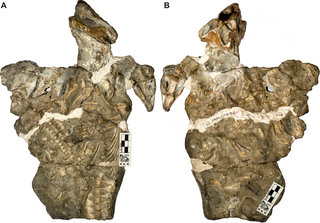
Galesaurus is an extinct genus of carnivorous cynodont therapsid that lived between the Induan and the Olenekian stages of the Early Triassic in what is now South Africa. It was incorrectly classified as a dinosaur by Sir Richard Owen in 1859.
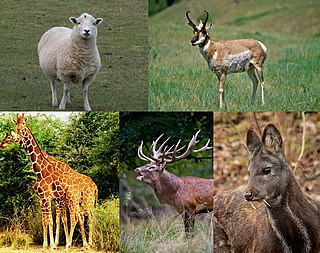
Pecora is an infraorder of even-toed hoofed mammals with ruminant digestion. Most members of Pecora have cranial appendages projecting from their frontal bones; only two extant genera lack them, Hydropotes and Moschus. The name "Pecora" comes from the Latin word pecus, which means "cattle". Although most pecorans have cranial appendages, only some of these are properly called "horns", and many scientists agree that these appendages did not arise from a common ancestor, but instead evolved independently on at least two occasions. Likewise, while Pecora as a group is supported by both molecular and morphological studies, morphological support for interrelationships between pecoran families is disputed.

Horned gophers are extinct rodents from the genus Ceratogaulus, a member of the extinct fossorial rodent clade Mylagaulidae. Ceratogaulus is the only known rodent genus with horns, and is the smallest known horned mammal. Ceratogaulus lived from the late Miocene to the early Pliocene epochs.

The Antilocapridae are a family of artiodactyls endemic to North America. Their closest extant relatives are the giraffids. Only one species, the pronghorn, is living today; all other members of the family are extinct. The living pronghorn is a small ruminant mammal resembling an antelope.
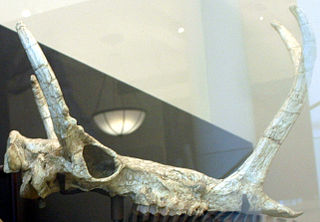
Synthetoceras tricornatus is a large, extinct protoceratid, endemic to North America during the Late Miocene, 10.3—5.3 Ma, existing for approximately 5 million years. Fossils have been recovered from Nebraska and Texas.
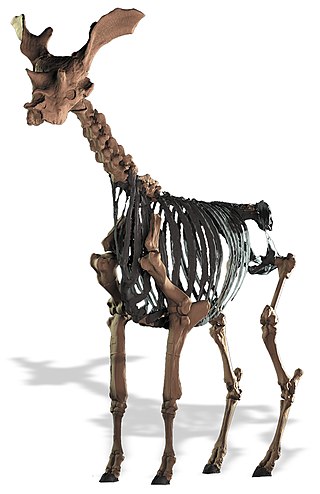
Sivatherium is an extinct genus of giraffids that ranged throughout Africa to the Indian subcontinent. The species Sivatherium giganteum is, by weight, one of the largest giraffids known, and also one of the largest ruminants of all time.
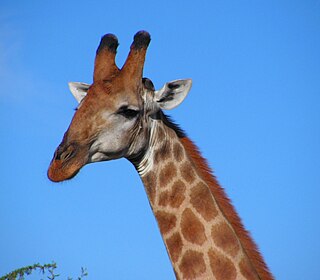
Ossicones are columnar or conical skin-covered bone structures on the heads of giraffes, male okapi, and some of their extinct relatives. Ossicones are distinguished from the superficially similar structures of horns and antlers by their unique development and a permanent covering of skin and fur.
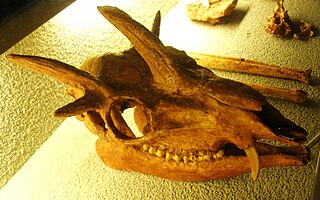
Hoplitomeryx is a genus of extinct deer-like ruminants which lived on the former Gargano Island during the Miocene and the Early Pliocene, now a peninsula on the east coast of South Italy. Hoplitomeryx, also known as "prongdeer", had five horns and sabre-like upper canines similar to a modern musk deer.
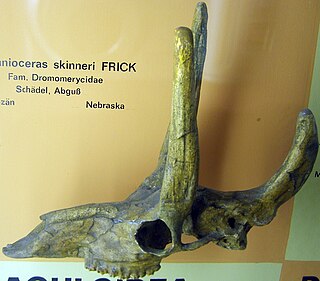
The Dromomerycidae is an extinct family of Neogene ruminants belonging to the infraorder Pecora. Dromomerycids, known by two subfamilies, were endemic to North America from the later early Miocene up to the early Pliocene, leaving no descendants. Dromomerycidae has a long history of uncertain taxonomic affiliations due to its superficial resemblances with the Eurasian Neogene Palaeomerycidae and were traditionally classified as subfamilies within the family. However, recent research differentiates the dromomerycids from the Giraffomorpha by the lack of sutures on the skull roof that typically make up the ossicones of the later clade. The similar resemblances of the appendages therefore could be the result of parallel evolution.

Palaeomeryx is an extinct genus of Artiodactyla, of the family Palaeomerycidae, endemic to Europe and Asia from the Miocene epoch, 16.9 – 7.25 Ma, existing for approximately 9.65 million years.

Cainotheriidae is an extinct family of artiodactyls known from the Late Eocene to Middle Miocene of Europe. They are mostly found preserved in karstic deposits.
Surameryx is an extinct genus of herbivorous even-toed ungulates originally described as belonging to the extinct family Palaeomerycidae. A single species, S. acrensis, was described from the Late Miocene of the Madre de Dios Formation, South America. It was originally interpreted as one of the few northern mammals that entered South America before the Pliocene. However, both its identification as a member of the family Palaeomerycidae and claims about its Miocene age were subsequently challenged.

Tranatocetus is an extinct genus of mysticete from the late Miocene (Tortonian) of Jutland, Denmark. The type and only species is Tranatocetus argillarius.
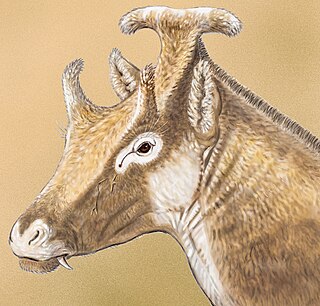
Xenokeryx is an extinct genus of ruminant known from the Miocene of Europe. The type species, Xenokeryx amidalae, was recovered from central Spain and bears a unique T-shaped protrusion from the top of the head. The specific epithet amidalae is in reference to the character Padmé Amidala from the Star Wars films "due to the striking resemblance that the occipital appendage of Xenokeryx bears to one of the hairstyles that the aforementioned character shows in The Phantom Menace feature film."

Giraffomorpha is a clade of pecoran ruminants containing the superfamilies Palaeomerycoidea (Palaeomerycidae) and Giraffoidea, of which the giraffe and okapi of the Giraffidae are the only extant members of the once-diverse clade as a result of a decline in diversity after the Miocene as a result of declines in temperatures. The clade is defined by the presence of ossicones, suggesting that the feature was developed as a result of basal, related evolutions between the two superfamilies rather than as an instance of parallel evolution. Giraffomorpha is also characterized by a lack of articular fossettes (hollows) in metatarsal bones III-IV.





















